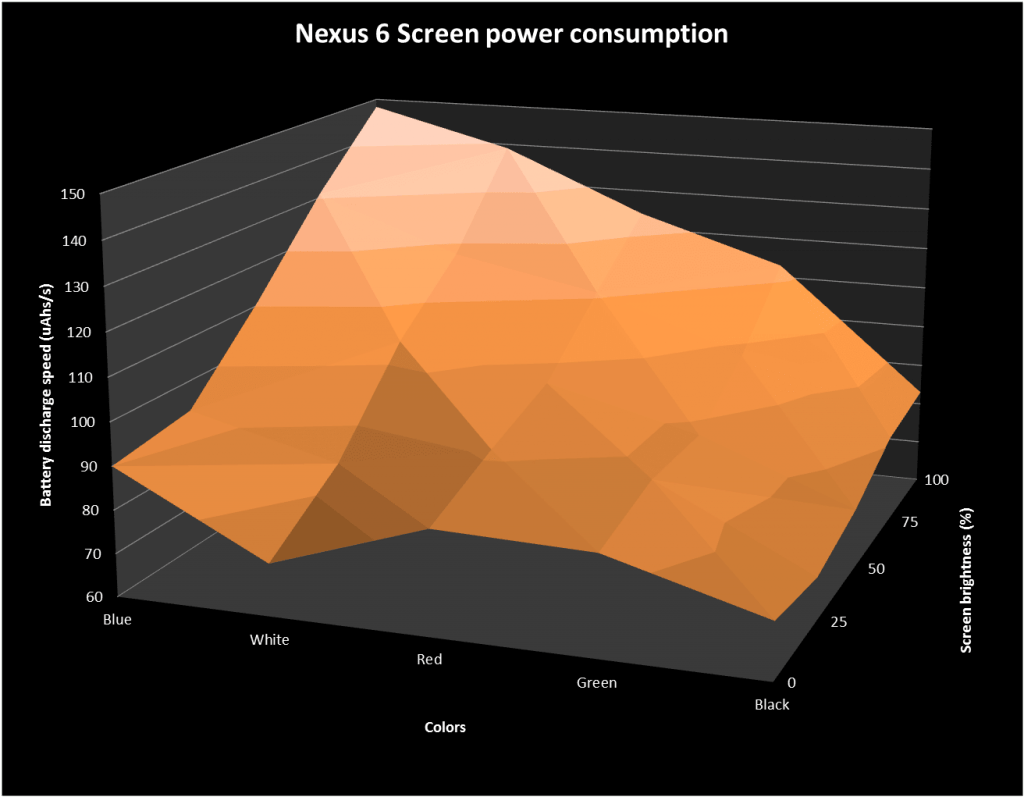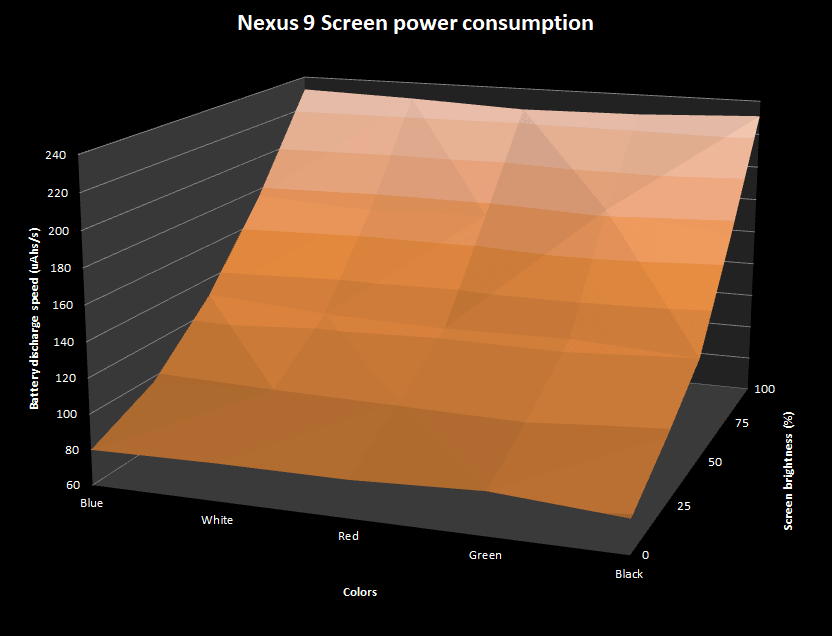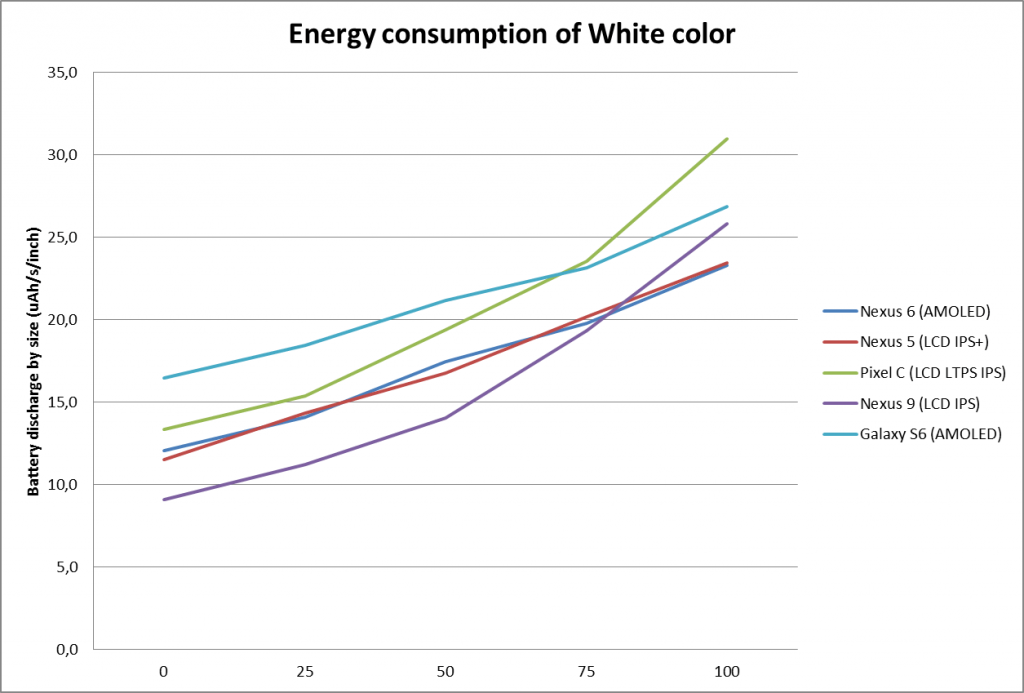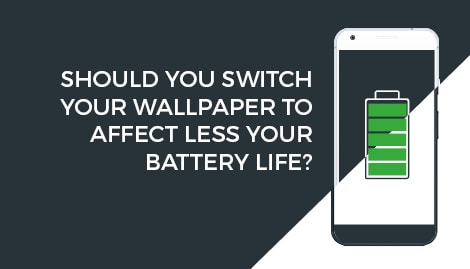Colors influencing power consumption of smartphones and tablets is a debate that never gets old. We hear a lot of preremptory assertions (like «pick a black wallpaper to consume less») which, most of the time, don’t take into account underlying technologies – though they are very diverse – or specific studies about the topic. So, as per usual, as a mobile-device-energy-measurement freak, I wanted to know more.
Why conducting this study?
Decreasing power consumption of mobile devices is a leitmotiv for all manufacturers. Indeed,battery life is one of the main criteria considered before buying a device. Manufacturers are working towards component optimization: improvement of processors efficiency, sensors technologies consuming less, increase in battery life capacity, etc. When I implemented the methodology for measurement of software power consumption at GREENSPECTOR, I had to go through and study every setting that could possibly influence this consumption. Yes, screens are part of it, but it seemed interesting to dig deeper the topic. Let’s have a look, shall we!
Testing Method
In order to measure energy behaviors of screens, I have created a series of tests making the screen brightness vary according to a rate (0%, 25%, 50%, 75% et 100%) and displaying a whole page in a specific color (Red, Green, Blue, Black, White). Then, I ran the tests on the different mobiles from our Power Test Cloud. Power consumptions (and other resources) are measured with GREENSPECTOR probes, installed on the devices. Finally, I get the measurement results back and I’m able to make cute graphs and can more easily interpret them.
First couple measures on a Nexus 6
I use my personal favorite device to begin with, the Motorola Nexus 6, which screen uses the AMOLED technology. We get the following cartography and consumptions: in abscissa are the different displayed colors, in depth is the brightness variation and on the ordinate axis we have the resulting battery life consumption:

First conclusions
- Consumption is lower for Black. I’m pretty glad, this confirms other studies such as this one or this one, and this is also what we theoretically expect from the AMOLED technology.
- The difference in consumption between colors is low when brightness is down. This seems intuitive but measures confirm it.
- Consumption is incremental in the following order: Black < Green < Red < White < Blue
- Diffferences can be very distinct: with maximum brightness, blue consumes 78% more energy than black (hence, a blue screen with a 100% brightness will empty the battery in 5h30, whereas a black screen with the same brightness will do it in 12h!).
Explanations
Nexus 6 is based on an AMOLED technology: Active-Matrix Organic Light-Emitting Diode. This technology connects the OLED technology (organic light-emitting diode) and active matrices (each pixel is commanded independently). It is an alternative to the historical LCD technology (Liquid Crystals displays).
Black is easy to display on AMOLED screens as pixels just need to be turned off. This is the reason why Black consumes less. White is a mix of Blue, Red and Green, we can find it on the average.
Measurement on a Samsung Galaxy S6
To be able to confirm this trend, I measured the Galaxy S6 energy behavior, exploiting a derived technology called Super AMOLED:

We can observe the same behavior with a slight difference: this time, white consumes the most (44% more than Black), just before Blue. Overall, observations are the same: Black is much less consuming, and White and Blue consume more than other colors.
Measurement on a Nexus 5
For AMOLED, it is obvious. But what about other technologies? Let’s take the example of the Nexus 5 for instance, with the LCD IPS+ technology:
{{< gsp-image title=”” src=”/assets/img/articles/2017-09-05-faut-il-changer-son-fond-ecran-pour-consommer-moins-de-batterie/NEXUS5-1-min.png” >}}
We can clearly see that with a LCD IPS+ screen, color doesn’t influence consumption. However, we can note that, with maximal brightness, White will consume just a bit more (4% gap, a 10 or 15 mn difference on the theoretical battery life).
IPS technology (In-Plane Switching) is a LCD technology. IPS+ adds LED to improve display. In LCD screens, theory is that consumption is independent from color: it’s all good then! By the way, let’s note that Retina technology of Apple products used to rely, up to now, on an IPS technology, but it seems like things are about to change with the new iPhone 8s with an OLED screen: iOS app designers, remember that.
Measurement on a Nexus 9
Measurement on a Nexus 9 tablet, based as well on an IPS technology, provides the following results:

Observations are similar to the Nexus 5 ones, with barely a 2% difference between colors.
Measurement on Pixel C
When measuring on the Google Pixel C tablet, a recent model with a LCD technology in the LTPS version, we get the following:

There is always an overall dependence of battery life consumption towards color. However, a color behaves a bit differently: with a maximum brightness, the White impact is 12% bigger than the Black (9h autonomy for Black versus 8h in White).
LCD LTPS (Low Temperature Poly-Silicon) is actually a Thin Film Transistor Technology (TFT) with an active matrices technology (like AMOLED). Differences on Whites probably comes from the possibility we have to whether or not turn on pixels.
Comparison for the user
Now we executed these tests, let’s try and compare these different models between each other. To do that, we take the consumption induced by the display of a black or white screen, and divide it by the screen size. When talking size, we don’t take into account the surface (which would be scientifically more correct), but simply the diagonal in inches, as it is the only information the user has access to: this is the one that matters when making a decision.

Based on an AMOLED technology, the Galaxy S6 has a rather high consumption. Same for the Pixel C with the LTPS IPS technology (with an incremental increase of consumption as brightness goes up). In Whites, no particular technology stands out. However, this analysis is to be considered cautiously as we didn’t measure a lot of devices.
By observing how Black behaves, we witness the whole point of the AMOLED technology which consumption is linear. One thing though, with minimum brightness (0%), consumption is more important than with other technologies. On the 25% – 50% range, there is no difference; and benefit is obvious for high brightness, for which AMOLED is the best suited.
Conclusion
Here comes the time to deliver our final verdict… Should you choose a black wallpaper for your smartphone or tablet?
Users
If you have an AMOLED screen: yes! No doubt here, pick your wallpaper picture predominantly black. (To find out what type of screen you have, look up characteristics on the manufacturer’s website or on sites dedicated to that matter). If your device is based on a different technology, you can always apply this best-practice, but battery life gains will be less important.
With the same reasoning, favor applications with black skins or interfaces (like Google Black for instance, or Twitter « night mode » …). And if your favorite app doesn’t offer a « dark » version, ask the editor!
To everyone: set brightness to the minimum required to still have a good user experience. Around 25%, current technologies allow to get a rather good rendering in most cases. Avoid to set at 100% permanently – it is usually the value I use outdoor on sunny days.
If you have the feature on your phone, activate the automatic brightness adaptation. Verify that it isn’t set too high, or a manual setting could be more efficient.
Profesionals with a company fleet
As per usual, settings and screen designs are under control, it is possible to pick the smartphone the most suitable to the actual use. Don’t rely only on manufacturers data, you can conduct specific tests that will give you better and clearer information on real battery life. Specify interfaces adapted to the phones. If you have a fleet with AMOLED screens, it is better to have darker interfaces rather than light ones to preserve the battery life of the devices in your fleet.
Designers
Color choice mainly depends on graphical charter and brand but energy consumption can be an additional criteria making your design furthermore efficient. It is interesting to ideally specify two themes: a dark one and a grey one. This would allow the user to pick the theme the most-adapted to its device.
Developers
In order to adapt design to hardware context, it is interesting to offer the user the choice of a darker theme. A screen modification option should be implmented (easy with CMS, more complicated with a framework).

